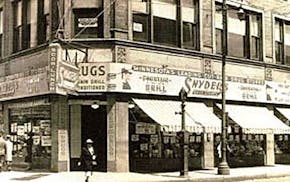Q: I apologize for an anthropomorphic observation: We enjoy birds at our cabin in Ely. Before the hummingbirds left in September, they hovered at the window near the feeder for two days. They seemed to be trying to get our attention, just as they do if we're late in filling the feeder. But the feeder was freshly filled and we even filled it again. The window-hovering behavior continued until they left after two days. It was as if they were thanking us and saying goodbye! Sounds silly but I can't get the concept out of my head.
A: There is no harm in believing that the birds visiting our feeders might feel a sense of gratitude. Hummingbirds are smart little creatures, and they quickly come to associate nectar feeders with the humans who fill them. One other possible explanation for this behavior: Your regular hummingbirds might have recently migrated and been replaced by two similar birds from farther north. But go with what you feel.
Tiny but tough
Q: I find it hard to believe that monarch butterflies and hummingbirds migrate thousands of miles. How do we know this?
A: I know, it's difficult to believe that a tiny backyard bird, only 3 ½ inches long and weighing a tenth of an ounce, can power its way to a winter home in Central America. But ruby-throated hummingbirds do make these long journeys, back and forth each year, and this has been proved by bird banding that established their astonishing range. Some ruby-throated hummingbirds travel from Canada as far south as Panama, although some spend the winter in coastal Florida. The autumn migrants tend to follow a land route around the Gulf of Mexico to reach their destinations, while in spring, most fly straight across the Gulf. Interestingly, at our latitude, hummingbirds seem to time their autumn travels to coincide with peak flowering of jewelweed (Impatiens capensis), a significant source of nectar for them.
As for monarchs, tags attached to their wings proved that those from eastern North America end up in the mountains of Mexico to spend the winter.
Downy hacking seeds
Q: I watched a downy woodpecker doing something unusual: It went back and forth from my feeder and seemed to be hiding seeds in a cracked 4 by 4. But a closer look showed only sunflower shells. I believe that the woodpecker was wedging seeds into the pole and then pecking them open. I'd never seen this before.
A: That's a very interesting observation, and it suggests that this woodpecker, at least, is operating as nuthatches do, jamming seeds into openings and then hacking them open. This is a good example of avian intelligence — coming up with savvy solutions to problems.
Most fishing hawks are en route
Q: When do osprey migrate out of our area?
A: The peak of fall migration for these fishing hawks is mid-September, according to Robert Janssen's "Birds in Minnesota." Some osprey head out in early September, while a few stay until late November.
Native plants are best
Q: I think you should put more emphasis on using native plants in home landscapes for birds, who could feed on the insects they attract and the seeds they produce. Natural sources of food are better for birds than nectar and seed in feeders.
A: I couldn't agree more about the importance of native plants in our yards and gardens, and it seems as if more and more gardeners are joining this trend. But there are times in the year — winter and early spring — when there is little food available in the natural world. It's at these times that our bird feeders can make a difference for birds.
Foiling bears
Q: I live in an area where bears can be a problem, and am looking for tips on when to stop feeding birds, to discourage bears.
A: People who feed birds in bear country say that there are two periods each year when bears tend to rip down bird feeders: In spring, when bears first emerge from their winter dens, they're ravenously hungry, and in autumn they turn into eating machines to put on fat for the coming winter. These are the two times of year when bird feeders should come down. Here's a link to a Minnesota DNR site with good ideas for helping birds without putting out feeders: dnr.state.mn.us/livingwith_wildlife/bears/index.html
It sounds as if you can safely feed birds November through March, when bears are denned up, but for the rest of the year you're going to have to take precautions. I checked in with several readers who have to deal with bears and they make a strong point that once a bear discovers a source of food, it'll return time and again.
Birds and storms
Q: I've been thinking about how severe weather events are increasing and the effects on birds while they nest and raise their young. For ducks, geese and swans it seems that eggs in a nest would likely be lost in flooding and young birds could be swept away. And bird nests in trees must suffer losses in high winds. Do they nest again or do they wait for next year?
A: I like the way you're thinking about birds. I'd say you're right about waterbirds: If the young aren't swept away from the protection of their parents, they have a good chance to survive flooding. However, if eggs in a nest are inundated, the birds will either need to start over or abandon nesting for the year. And many songbirds will build a new nest if their first one is ruined, if this happens early enough in the season. If a nest is lost later, the birds might not have time to start over, and may just disperse for the season.
Note to readers: A recent question about robins following a lawn mower for insects kicked up by its blades inspired this observation from a reader, whose catbirds follow the mower and cardinals keep an ear out for the sprinkling system: "When we turn on the water to the system at the hydrant, there's a sort of 'clunk' caused by the change in water pressure in the pipes. It's probably a good 15 seconds later that the water starts spurting out, but a cardinal will have already hopped down from the lilac tree, ready to bathe in the spray."
St. Paul resident Val Cunningham, a member of the St. Paul Bird Alliance (formerly Audubon Society), writes about nature for various publications. She can be reached at valwrites@comcast.net.

When West Seventh Pharmacy closes, St. Paul will lose a piece of history and personal care

John Cusack dishes on 'High Fidelity' at Minneapolis screening

For 'Legally Blonde' star, 'being underestimated is her secret superpower'

Restaurant openings and closings in the Twin Cities

